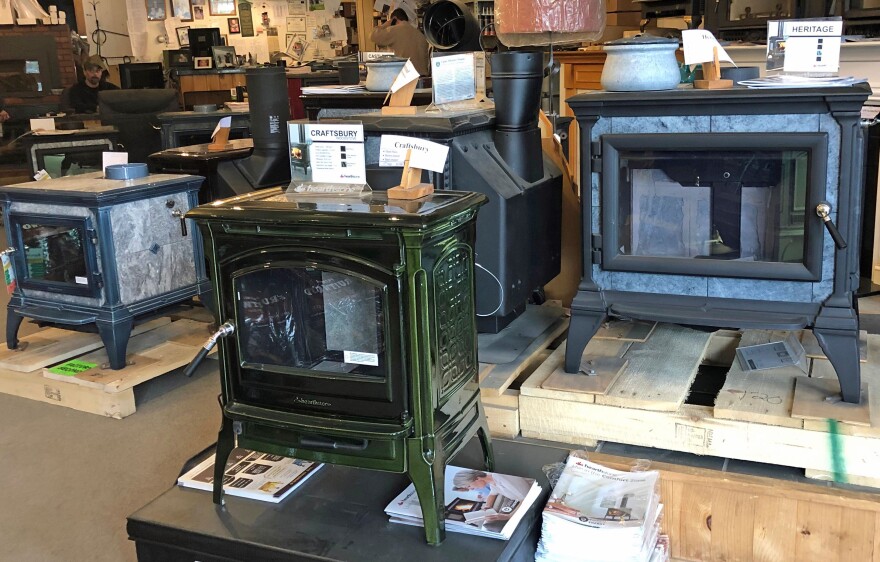Two years ago, the state offered Vermonters money to buy a new wood or pellet stove if they got rid of an old, polluting stove. The program was so popular, they decided to do it again this year (with a few changes). So how many people have taken advantage of these different iterations of the wood stove change-out program?
VPR's Did It Work? series looks at a sampling of publicly-funded initiatives in Vermont of the past several years. More from the series here.
The Initiative
In 1988, the federal Environmental Protection Agency began certifying wood stoves to meet air quality standards. The EPA started setting emission limits that are measured in grams per hour of dust particles coming out your chimney, explained David Kuhfahl — the president of HearthStone, a wood stove manufacturer in Morrisville.
For new stoves on the market, Kuhfahl said, those limits then became more restrictive in 2015.
"The existing EPA standard has been 7.5 grams an hour," said Kuhfahl, "and in 2015 anything that wasn’t under 4.5 grams an hour became obsolete."
During the winter of 2016-2017, the state's Clean Energy Development Fund offered incentives for Vermonters to change out their pre-1988 wood stoves for new, more efficient and cleaner-burning stoves.
In just a matter of months, all $200,000 set aside for the program was gone. The Vermont Department of Environmental Conservation's Air Quality and Climate Division kicked in another $100,000 to keep it going.

The current wood stove standard is the one set in 2015, but even stricter EPA standards are set to take effect in May 2020.
This past winter the state brought the change-out program back with some modifications: the state offered up less money per customer and only gave it to people buying stoves that meet the strictest pollution standards. According to Kuhfahl, the newest stoves meet or exceed EPA standards that go into effect a year from now and mandate a maximum two grams per hour.
This latest round was funded with $400,000 — half from the Clean Energy Development Fund and half from the Air Quality and Climate Division. The program is still running.
What Happened
Andrew Perchlik is in charge of the change-out program for the Clean Energy Development Fund. He explained that first program gave away $300,000 during the winter of 2016 to 2017, resulting in 247 old wood stoves being switched out for new wood or pellet stoves.

But the program was kind of complicated. There were four different incentive amounts – ranging from $500 to $1,500, depending on how clean the new stove burned. The cleaner the stove, the higher the incentive; most people went for the $1,500 option.
"We learned, one, that maybe that top incentive was too high," said Perchlik. "We also learned that there wasn’t as much of a connection to how clean the stove was to the cost. The reason we did [a] $1,500 incentive last time is those were for the most clean-burning stoves, the most efficient. But we found out that … the most efficient wasn’t necessarily the most expensive."
Perchlik said they also learned there should be some form of low-income component to the program. So when the state brought the program back this winter, they implemented some changes.
They increased the overall pool to $400,000, and they also created a few different programs. There's now one program specifically for lower-income Vermonters.
Then there’s another program, like the original from 2016-2017, that's open to anyone with a pre-1988 wood stove to change out. But the incentives are flat this time around: $1,000 for a new pellet stove or $800 for a new cordwood stove. Additionally, the program is only offered to people buying stoves that meet the EPA standards going into effect in 2020.
There’s also a third program, run through Efficiency Vermont, which offers a $650 incentive to people who don't have an older stove to exchange.

Participating wood stove dealers like Peter L'Esperance at Chimney Sweep II, in Berlin, are well-versed in the changing EPA standards and the various incentive programs in Vermont.
Essentially, L’Esperance said, the goal is for Vermonters to get rid of wood stoves made in the 1970s: "Basically those stoves have an efficiency of less than 50% and do create a fair amount of air pollution," he said.
The mission is to replace those stoves with models that meet new EPA standards that go into effect in May 2020.
Kuhfahl, the president of HearthStone, said today's most efficient stoves burn about half as much wood as the older models from the 1970s and 1980s. He said the newest stoves — those ones that meet or exceed next year's standards — burn everything three times, so there's less soot going up the chimney.
"You’ve always had primary combustion, which is your basic fire. Then we had secondary combustion, which would burn off the gasses," Kuhfahl explained. "And now we've got tertiary combustion through a catalytic combustor, not unlike your automobile. And that takes the final amounts of CO [carbon monoxide], in whatever form it is, or just plain old carbon, and burns it one more time."
Did It Work?
With 247 old stoves swapped for new ones, there's no doubt the 2016-2017 program exceeded its goals. But is the new, revised incentive program working as well as its predecessor?
Since the latest version of the program is still running, it's too early to know. To date, 112 old wood stoves have been changed out under the new program, so it’s off to a slower start than the old program.
But, retailers say they’re still busy — and there's also an unknown number of stoves that have been sold, but have yet to be installed. Those stoves won't be counted toward the program until they've been installed, and there's a bit of a backlog there.
Under the new program, the money can only be used for the stoves that meet the 2020 EPA standards, which are even stricter than the 2015 standards. So from an air-quality standpoint, there could be a greater impact even if fewer stoves are switched over.
More from VPR — Brave Little State: What Are The Pros And Cons Of Heating With Wood? [Jan. 2019]
Perchlik, who oversees the program for the Clean Energy Development Fund, said the current iteration will run until July 1. If there’s still money left in the pot, they may make a few more tweaks and set a new end date for the program, and the incentive amount could change again.
"This is public money and so we want to make sure we’re using it as efficiently as possible and getting the biggest bang for the buck," said Perchlik. "So yeah, we’re trying to set that incentive that moves people to do this change-out, because we think it’s in the public good if people change out these old stoves."
"But we don’t want to over-incentivize," Perchlik continued. "If they were gonna do it anyway, we don’t want to just give 'em money to do it. So, that is the balance that you do when you run an incentive program."
Even though they may change the program again, Perchlik said he still believes it's working.

While we hear a lot about new initiatives or funding when first announced, it's not always as easy to figure out whether they lived up to their promises down the line — and if they were a good use of taxpayer money. In VPR's Did It Work? series, we're following up at a sampling of publicly-funded initiatives in Vermont of the past several years. More from the series here.





